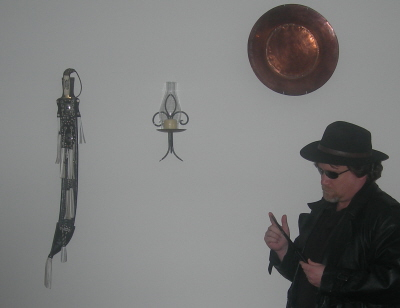|
About This Author
Come closer.
|
Complex Numbers
Complex Numbers
A complex number is expressed in the standard form a + bi, where a and b are real numbers and i is defined by i^2 = -1 (that is, i is the square root of -1). For example, 3 + 2i is a complex number.
The bi term is often referred to as an imaginary number (though this may be misleading, as it is no more "imaginary" than the symbolic abstractions we know as the "real" numbers). Thus, every complex number has a real part, a, and an imaginary part, bi.
Complex numbers are often represented on a graph known as the "complex plane," where the horizontal axis represents the infinity of real numbers, and the vertical axis represents the infinity of imaginary numbers. Thus, each complex number has a unique representation on the complex plane: some closer to real; others, more imaginary. If a = b, the number is equal parts real and imaginary.
Very simple transformations applied to numbers in the complex plane can lead to fractal structures of enormous intricacy and astonishing beauty.
| |
Today, I'm going to talk about nothing.
And no, despite the borderline clickbait title, this article isn't about philosophical nihilism, but the physical emptiness of space.
Just had to clarify that because, well, in this blog, it could go either way.
In 1654 a German scientist and politician named Otto von Guericke was supposed to be busy being the mayor of Magdeburg. But instead he was putting on a demonstration for lords of the Holy Roman Empire. With his newfangled invention, a vacuum pump, he sucked the air out of a copper sphere constructed of two hemispheres. He then had two teams of horses, 15 in each, attempt to pull the hemispheres apart. To the astonishment of the royal onlookers, the horses couldn’t separate the hemispheres because of the overwhelming pressure of the atmosphere around them.
I vaguely remember seeing an illustration of this when I was quite young. Too young to fully comprehend the implications, but old enough to go "why didn't they use tractors?"
Scientists, philosophers, and theologians across the globe had debated the existence of the vacuum for millennia, and here was von Guericke and a bunch of horses showing that it was real.
To be clear: it's not that a vacuum has the power to glue hemispheres together. It's that the air pressure that surrounds and permeates us is actually quite strong. We just don't notice it because we (usually) have equilibrium to it.
But the idea of the vacuum remained uncomfortable, and only begrudgingly acknowledged. We might be able to artificially create a vacuum with enough cleverness here on Earth, but nature abhorred the idea.
My dad, whom I primarily credit with my interest in science (I think he's the one who showed me that vacuum drawing and tried to explain it to me as a kid), always told me "nature abhors a vacuum." I'm still skeptical of that old folk wisdom. If nature abhors it so much, then why is the vast majority of the universe vacuum?
Scientists produced a compromise: The space of space was filled with a fifth element, an aether, a substance that did not have much in the way of manifest properties, but it most definitely wasn’t nothing.
Lots to unpack here. I think that by "fifth element" they're not talking about awesome Bruce Willis movies, but to the old paradigm of earth, air, fire, and water, which, I feel obliged to point out, is Eurocentric in origin.
And I've been saying for years that our current conception of "dark matter" reminds me very strongly of "aether," in that scientists have hypothesized a substance that has properties to fit observation, something without "much in the way of manifest properties." Aether turned out to be something else entirely (the aether bunny doesn't exist); will the same become true of dark matter?
Not that there's anything wrong with that. You gotta start somewhere, and that's hypothesis based on observation. If it's disproved later, well, that's science.
In the 1920s astronomer Edwin Hubble discovered that the Andromeda nebula was actually the Andromeda galaxy, an island home of billions of stars sitting a staggering 2.5 million light-years away. As far as we could tell, all those lonely light-years were filled with not much at all, just the occasional lost hydrogen atom or wandering photon.
Poetic, but photons aren't particles of mass, so their presence or absence doesn't change what we usually mean by "vacuum."
At subatomic scales, scientists were also discovering atoms to be surprisingly empty places. If you were to rescale a hydrogen atom so that its nucleus was the size of a basketball, the nearest electron would sit around two miles away.
I didn't bother fact-checking this scale analogy, but it tracks, though it may be misleading to talk about the size of an electron.
Within the emptiness that dominates the volume of an atom and the volume of the universe, physicists found something. Far from the sedate aether of yore, this something is strong enough to be tearing our universe apart. The void, it turns out, is alive.
Oh for fuck's sake... okay, okay, calm down, poetic license.
In the late 1990s, two independent teams of astronomers discovered that the expansion of the universe is accelerating, meaning that our universe grows larger and larger faster and faster every day. The exact present-day expansion rate is still a matter of some debate among cosmologists, but the reality is clear: Something is making the universe blow up. It appears as a repulsive gravitational force, and we’ve named it dark energy.
This, not the creative prose, is why I saved this article. Because the irony doesn't escape me: the presence of vacuum (so to speak) was proven because teams of horses couldn't pull apart an empty copper sphere containing vacuum (again, so to speak). And now, vacuum-associated dark energy seems to be causing galaxies to fly apart.
The trick here is that the vacuum, first demonstrated by von Guericke all those centuries ago, is not as empty as it seems. If you were to take a box (or, following von Guericke’s example, two hemispheres), and remove everything from it, including all the particles, all the light, all the everything, you would not be left with, strictly speaking, nothing. What you’d be left with is the vacuum of spacetime itself, which we’ve learned is an entity in its own right.
That's right: there are degrees of nothing. When we talk about "vacuum" (and we're not referring to our Hoover), we usually mean relative lack of matter particles.
In any case, there's more to the article, and it's an interesting summary on where cosmology is now as regards emptiness and universal expansion. But I've gone on long enough, and made the point I wanted to make. So I have "nothing" more to say today. |
© Copyright 2025 Robert Waltz (UN: cathartes02 at Writing.Com). All rights reserved.
Robert Waltz has granted InkSpot.Com, its affiliates and its syndicates non-exclusive rights to display this work.
|

